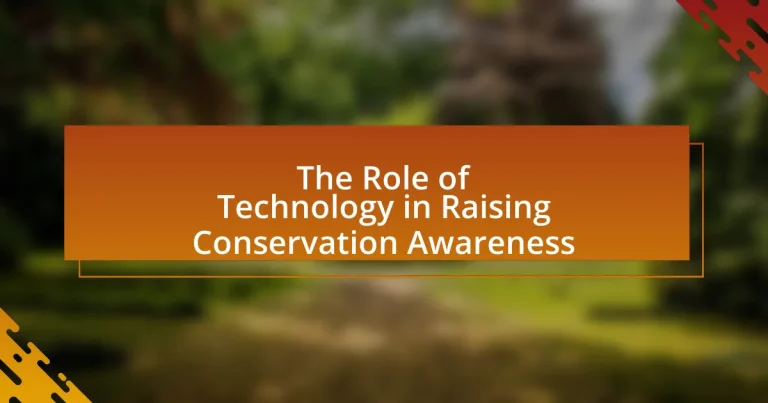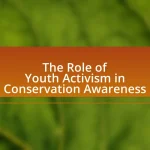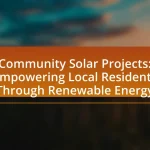The main entity of the article is the role of technology in raising conservation awareness. The article outlines how various technological tools, including social media, mobile applications, virtual reality, drones, and satellite imagery, enhance communication, education, and engagement in conservation efforts. It discusses the effectiveness of these technologies in shaping public perception, fostering community involvement, and facilitating collaboration among conservation organizations. Key insights include the impact of interactive technology on knowledge retention, the advantages of gamification in apps, and the importance of data sharing for informed decision-making in conservation initiatives. Overall, the article emphasizes the critical role technology plays in mobilizing public action and enhancing understanding of environmental challenges.
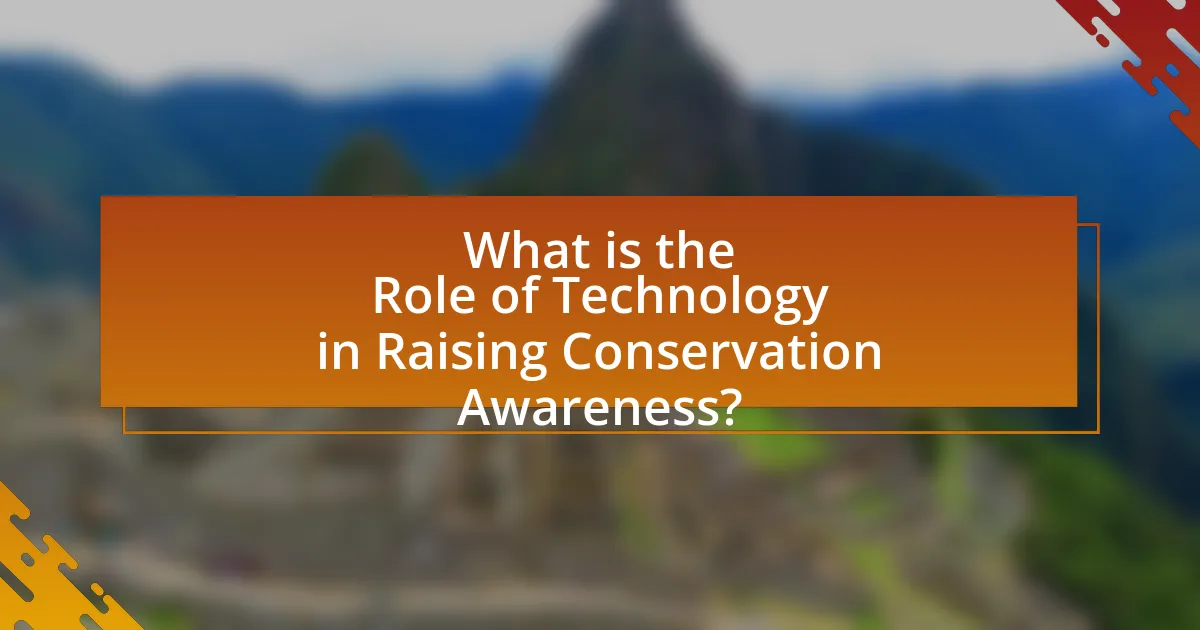
What is the Role of Technology in Raising Conservation Awareness?
Technology plays a crucial role in raising conservation awareness by facilitating communication, education, and engagement with diverse audiences. Digital platforms, such as social media and websites, enable organizations to disseminate information about conservation issues rapidly and widely, reaching millions of people. For instance, campaigns like Earth Hour leverage social media to encourage global participation in environmental initiatives, demonstrating the power of technology in mobilizing public action. Additionally, interactive tools like virtual reality experiences allow users to immerse themselves in endangered ecosystems, fostering a deeper emotional connection to conservation efforts. Research indicates that visual storytelling through technology can significantly enhance public understanding of environmental challenges, making complex issues more relatable and urgent.
How does technology influence public perception of conservation issues?
Technology significantly influences public perception of conservation issues by enhancing awareness and engagement through digital platforms and social media. For instance, social media campaigns can rapidly disseminate information about endangered species and habitat loss, reaching millions of users and fostering a sense of urgency. A study by the Pew Research Center found that 69% of adults in the U.S. use social media, which amplifies conservation messages and mobilizes community action. Additionally, technologies like virtual reality and interactive apps provide immersive experiences that educate users about environmental challenges, making the issues more relatable and pressing. This combination of broad reach and engaging content shapes public attitudes and encourages proactive behaviors toward conservation.
What types of technology are most effective in conservation awareness campaigns?
Digital media platforms, mobile applications, and virtual reality are the most effective technologies in conservation awareness campaigns. Digital media platforms, such as social media, enable organizations to reach a broad audience quickly, facilitating the dissemination of information and engagement through interactive content. Mobile applications provide users with tools for tracking wildlife, reporting environmental issues, and accessing educational resources, enhancing personal involvement in conservation efforts. Virtual reality offers immersive experiences that can evoke emotional responses and foster a deeper understanding of conservation challenges, as evidenced by projects like “The Wild Immersion,” which allows users to experience endangered habitats firsthand. These technologies collectively enhance awareness, engagement, and education in conservation initiatives.
How do social media platforms contribute to conservation messaging?
Social media platforms significantly enhance conservation messaging by facilitating widespread information dissemination and community engagement. These platforms allow conservation organizations to share real-time updates, educational content, and success stories, reaching millions of users globally. For instance, a study by the Pew Research Center found that 69% of adults in the U.S. use social media, providing a vast audience for conservation messages. Additionally, social media enables interactive campaigns, such as hashtag movements, which can mobilize public support and raise awareness about specific environmental issues, exemplified by campaigns like #SaveTheWhales. This interactive nature fosters a sense of community and encourages user-generated content, amplifying the reach and impact of conservation efforts.
Why is technology essential for conservation education?
Technology is essential for conservation education because it enhances accessibility, engagement, and effectiveness in disseminating information about environmental issues. Digital platforms, such as online courses and interactive apps, allow a broader audience to access educational resources, breaking geographical barriers. For instance, a study by the National Oceanic and Atmospheric Administration found that virtual reality experiences can increase empathy and understanding of marine conservation issues, leading to greater public support for conservation initiatives. Additionally, technology facilitates real-time data sharing and collaboration among conservationists, educators, and the public, fostering a more informed and active community in conservation efforts.
What are the benefits of using interactive technology in conservation education?
Using interactive technology in conservation education enhances engagement, improves knowledge retention, and fosters a deeper emotional connection to environmental issues. Interactive tools, such as virtual reality and gamified learning experiences, allow learners to explore ecosystems and wildlife in immersive ways, making complex concepts more accessible. Research indicates that students who engage with interactive technology demonstrate a 30% higher retention rate of information compared to traditional methods, as evidenced by studies conducted by the University of California, which highlight the effectiveness of experiential learning in environmental education. This approach not only informs but also inspires action towards conservation efforts.
How can virtual reality enhance the understanding of conservation challenges?
Virtual reality can enhance the understanding of conservation challenges by providing immersive experiences that simulate real-world environments and scenarios. This technology allows users to engage with ecosystems and wildlife in a way that traditional media cannot, fostering empathy and a deeper emotional connection to conservation issues. For instance, studies have shown that virtual reality experiences can increase awareness of habitat destruction and species extinction by allowing users to witness these challenges firsthand, leading to a greater understanding of the urgency for conservation efforts. Research conducted by the University of Maryland found that participants who experienced virtual reality simulations of endangered habitats reported a significant increase in their intention to support conservation initiatives.
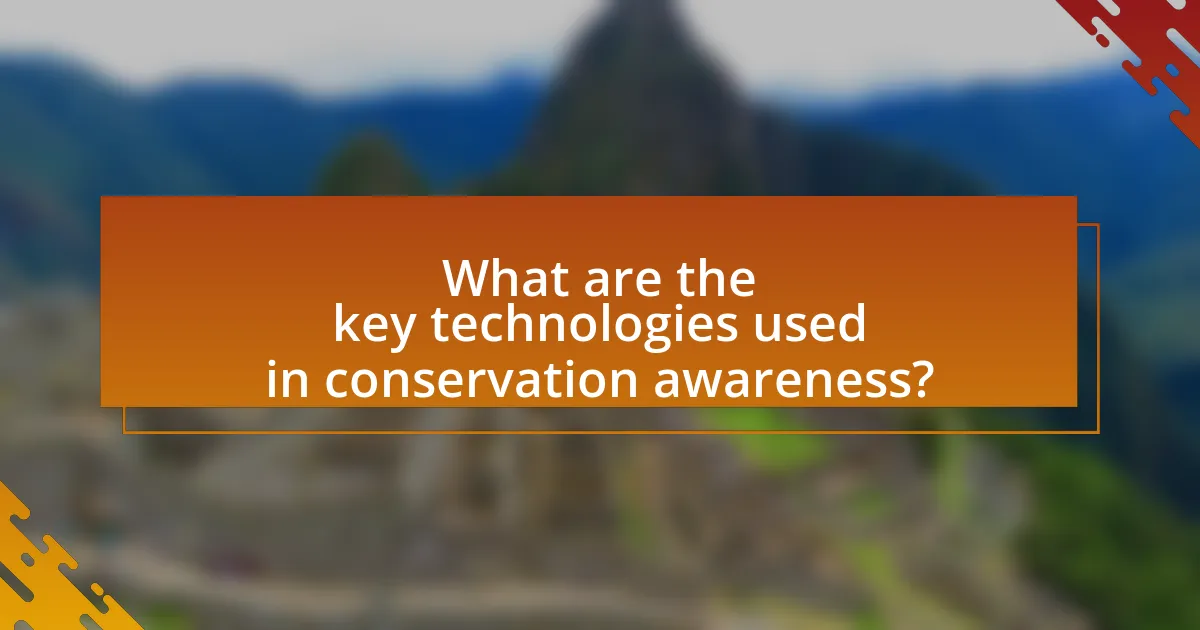
What are the key technologies used in conservation awareness?
Key technologies used in conservation awareness include social media platforms, mobile applications, Geographic Information Systems (GIS), and virtual reality (VR). Social media platforms facilitate the rapid dissemination of information and engagement with a global audience, exemplified by campaigns like #EarthDay. Mobile applications provide users with tools for tracking wildlife and reporting environmental issues, such as the iNaturalist app, which has over 1.5 million users contributing to biodiversity data. Geographic Information Systems (GIS) enable the visualization and analysis of environmental data, aiding in conservation planning and public awareness, as seen in projects like the Global Forest Watch. Virtual reality (VR) immerses users in simulated environments, enhancing empathy and understanding of conservation issues, demonstrated by initiatives like the “The Wild Immersion” project. These technologies collectively enhance public engagement and education regarding conservation efforts.
How do mobile applications support conservation efforts?
Mobile applications support conservation efforts by facilitating data collection, raising awareness, and promoting community engagement. For instance, apps like iNaturalist allow users to document and share biodiversity observations, contributing to scientific research and conservation planning. Additionally, platforms such as WWF’s Together app educate users about endangered species and encourage donations for conservation projects. Research indicates that mobile technology can enhance public participation in conservation initiatives, as evidenced by a study published in the journal “Conservation Biology,” which found that citizen science apps significantly increased user involvement in environmental monitoring.
What features make conservation apps effective for user engagement?
Conservation apps are effective for user engagement due to features such as gamification, social sharing capabilities, and personalized content. Gamification, which incorporates game-like elements such as rewards and challenges, has been shown to increase user motivation and participation, as evidenced by studies indicating that users are more likely to engage with content that offers interactive experiences. Social sharing capabilities allow users to share their achievements and experiences with their networks, fostering a sense of community and encouraging others to participate, which is supported by research highlighting the impact of social influence on behavior change. Personalized content, tailored to individual interests and behaviors, enhances user relevance and retention, as studies demonstrate that users are more likely to engage with content that resonates with their personal values and goals.
How can gamification in apps promote conservation awareness?
Gamification in apps can promote conservation awareness by engaging users through interactive challenges and rewards that highlight environmental issues. For instance, apps like “Sea Hero Quest” use gameplay to raise awareness about marine conservation while collecting valuable data for scientific research. This approach not only educates users about conservation but also motivates them to take action, as evidenced by studies showing that gamified experiences can increase user engagement by up to 50%. By integrating educational content with enjoyable gameplay, gamification effectively fosters a deeper understanding of conservation efforts and encourages sustainable behaviors.
What role do drones and satellite imagery play in conservation?
Drones and satellite imagery play a crucial role in conservation by providing high-resolution data for monitoring ecosystems and wildlife. These technologies enable conservationists to track changes in land use, assess habitat conditions, and monitor species populations with greater accuracy and efficiency. For instance, a study published in the journal “Remote Sensing” demonstrated that satellite imagery can detect deforestation rates with an accuracy of over 90%, allowing for timely interventions. Additionally, drones can access remote areas, capturing detailed images that help identify illegal activities such as poaching or logging. This combination of aerial data collection enhances the ability to make informed decisions for conservation efforts, ultimately supporting biodiversity preservation and ecosystem management.
How do drones assist in monitoring wildlife and habitats?
Drones assist in monitoring wildlife and habitats by providing aerial surveillance that captures high-resolution images and data over large areas. This technology enables researchers to track animal movements, assess population sizes, and monitor habitat conditions without disturbing the wildlife. For instance, a study published in the journal “Remote Sensing” demonstrated that drones could effectively survey elephant populations in Africa, revealing accurate counts and behavioral patterns that traditional methods often miss. Additionally, drones facilitate the monitoring of environmental changes, such as deforestation or habitat degradation, allowing conservationists to respond promptly to threats.
What are the advantages of using satellite imagery for conservation planning?
Satellite imagery offers significant advantages for conservation planning by providing comprehensive, real-time data on land use, habitat changes, and biodiversity. This technology enables conservationists to monitor environmental changes over large areas, facilitating the identification of critical habitats and the assessment of threats such as deforestation and urbanization. For instance, a study published in the journal “Remote Sensing” demonstrated that satellite imagery can detect changes in forest cover with an accuracy of over 90%, allowing for timely interventions. Additionally, satellite data supports the integration of various datasets, enhancing decision-making processes and resource allocation for conservation efforts.
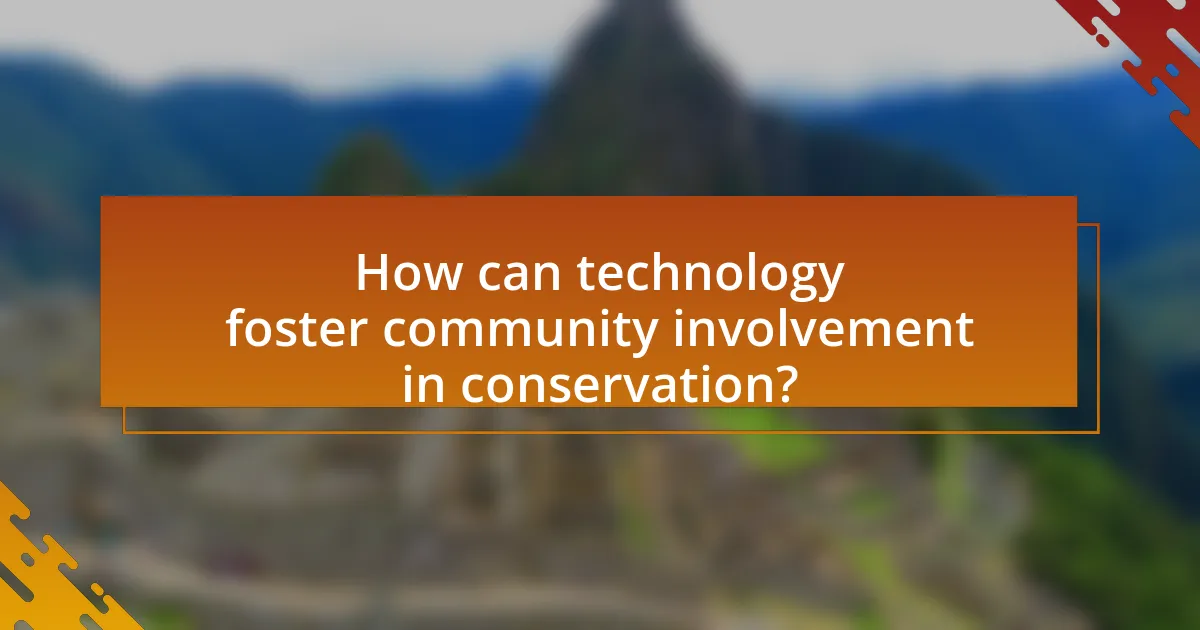
How can technology foster community involvement in conservation?
Technology can foster community involvement in conservation by providing platforms for education, engagement, and collaboration. Digital tools such as mobile apps and social media enable communities to share information about local conservation efforts, track wildlife, and report environmental issues. For instance, platforms like iNaturalist allow users to document biodiversity, contributing to scientific research while fostering a sense of community ownership over local ecosystems. Additionally, virtual reality experiences can immerse individuals in conservation challenges, enhancing empathy and motivating action. Research shows that communities engaged through technology are more likely to participate in conservation activities, as evidenced by a study published in the journal “Conservation Biology,” which found that digital engagement increased volunteer participation by 40%.
What platforms facilitate community engagement in conservation projects?
Social media platforms, mobile applications, and online forums facilitate community engagement in conservation projects. These platforms enable individuals and organizations to share information, mobilize support, and collaborate on conservation efforts. For instance, Facebook and Instagram allow users to create awareness campaigns, while apps like iNaturalist encourage citizen science by enabling users to document and share biodiversity observations. Research indicates that social media can significantly increase public participation in conservation initiatives, as evidenced by a study published in the journal “Conservation Biology,” which found that social media campaigns led to a 30% increase in volunteer participation in local conservation projects.
How can crowdfunding platforms support conservation initiatives?
Crowdfunding platforms can support conservation initiatives by providing a financial mechanism for individuals and organizations to raise funds for specific environmental projects. These platforms enable project creators to present their conservation goals to a global audience, allowing them to gather small contributions from many supporters, which can lead to significant funding. For instance, a study by the University of California found that crowdfunding campaigns for environmental projects raised an average of $10,000, demonstrating the potential for substantial financial support. Additionally, crowdfunding platforms often include features that enhance visibility and engagement, such as social sharing tools and updates on project progress, which can further mobilize community support and awareness for conservation efforts.
What role do online forums play in building conservation communities?
Online forums play a crucial role in building conservation communities by facilitating communication, knowledge sharing, and collaboration among individuals passionate about environmental issues. These platforms enable users to exchange ideas, share experiences, and disseminate information about conservation efforts, thereby fostering a sense of community and collective action. For instance, studies have shown that online forums can enhance engagement and mobilization for conservation initiatives, as they provide a space for users to organize events, campaigns, and discussions that promote awareness and action.
How can technology enhance collaboration among conservation organizations?
Technology enhances collaboration among conservation organizations by providing platforms for real-time communication, data sharing, and project management. Tools such as cloud-based software enable organizations to access and share critical information instantly, facilitating joint efforts in conservation initiatives. For instance, the use of Geographic Information Systems (GIS) allows multiple organizations to visualize and analyze spatial data collaboratively, improving decision-making processes. Additionally, online collaboration tools like Slack or Trello streamline project coordination, ensuring that teams remain aligned and efficient. Research indicates that organizations utilizing these technologies report increased effectiveness in achieving conservation goals, as evidenced by a study published in the journal “Conservation Biology,” which found that collaborative projects leveraging technology had a 30% higher success rate in biodiversity outcomes compared to those that did not.
What tools are available for data sharing among conservationists?
Data sharing among conservationists is facilitated by several tools, including platforms like Conservation Data Manager, Global Biodiversity Information Facility (GBIF), and iNaturalist. Conservation Data Manager allows organizations to manage and share biodiversity data effectively, while GBIF provides a global framework for sharing biodiversity data across countries and institutions. iNaturalist enables citizen scientists and conservationists to document and share observations of wildlife, contributing to a collective database that supports conservation efforts. These tools enhance collaboration and data accessibility, which are crucial for informed decision-making in conservation initiatives.
How does technology streamline communication between organizations and the public?
Technology streamlines communication between organizations and the public by enabling real-time information sharing and enhancing engagement through various digital platforms. For instance, social media allows organizations to disseminate updates quickly, reaching a broad audience instantly, which is crucial for raising awareness about conservation efforts. According to a study by the Pew Research Center, 69% of adults in the U.S. use social media, making it an effective tool for organizations to connect with the public. Additionally, mobile applications facilitate direct communication, allowing users to receive notifications and participate in initiatives, thereby fostering a two-way dialogue that enhances community involvement in conservation activities.
What are best practices for leveraging technology in conservation awareness?
Best practices for leveraging technology in conservation awareness include utilizing social media platforms to disseminate information widely, employing mobile applications for real-time reporting of environmental issues, and integrating virtual reality experiences to engage users in immersive educational content. Social media, with over 4.5 billion users globally, allows organizations to reach diverse audiences quickly and effectively, fostering community engagement and activism. Mobile applications, such as iNaturalist, enable users to document biodiversity and contribute to citizen science, enhancing public participation in conservation efforts. Virtual reality experiences, like those offered by the National Geographic, provide users with firsthand experiences of endangered ecosystems, increasing empathy and understanding of conservation challenges. These practices collectively enhance awareness and drive action towards conservation initiatives.
How can organizations effectively measure the impact of their technology-driven campaigns?
Organizations can effectively measure the impact of their technology-driven campaigns by utilizing key performance indicators (KPIs) such as engagement rates, conversion rates, and return on investment (ROI). These metrics provide quantifiable data that reflects the effectiveness of the campaigns. For instance, a study by the Digital Marketing Institute found that campaigns utilizing data analytics saw a 20% increase in engagement compared to those that did not. Additionally, organizations can employ tools like Google Analytics to track user interactions and behavior, allowing for real-time adjustments and improvements. By analyzing these metrics, organizations can gain insights into audience behavior and campaign effectiveness, ultimately enhancing their conservation awareness efforts.
What strategies can enhance the reach of conservation messages through technology?
Utilizing social media platforms significantly enhances the reach of conservation messages through technology. Social media allows for the rapid dissemination of information to a global audience, with platforms like Facebook, Twitter, and Instagram enabling organizations to share compelling visuals and stories that resonate with users. According to a study by the Pew Research Center, 69% of adults in the U.S. use social media, making it a powerful tool for engaging diverse demographics in conservation efforts.
Additionally, leveraging mobile applications can facilitate direct engagement with users, providing real-time updates on conservation initiatives and opportunities for involvement. For instance, apps like iNaturalist encourage citizen science by allowing users to document and share biodiversity observations, thus fostering a community of conservation-minded individuals.
Moreover, employing data analytics can help organizations tailor their messages to specific audiences, increasing the effectiveness of outreach campaigns. Research from the Harvard Business Review indicates that data-driven marketing strategies can improve engagement rates by up to 30%.
Incorporating multimedia content, such as videos and interactive infographics, can also enhance message retention and shareability, as studies show that visual content is more likely to be shared on social media than text-based content. Overall, these strategies collectively amplify the impact of conservation messages, making them more accessible and engaging to a wider audience.
